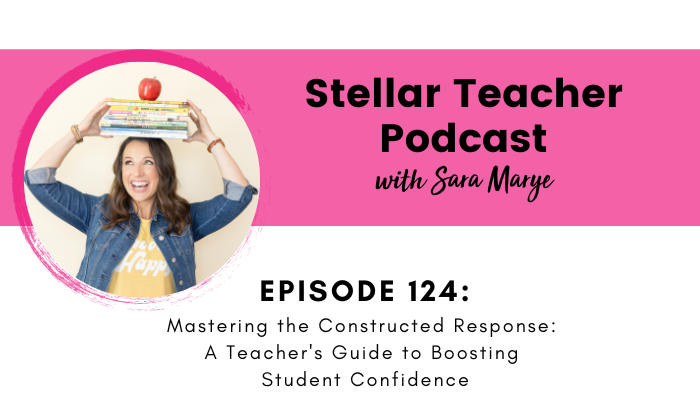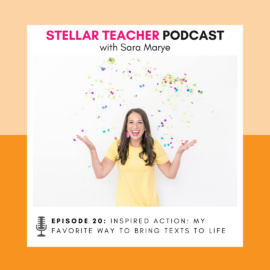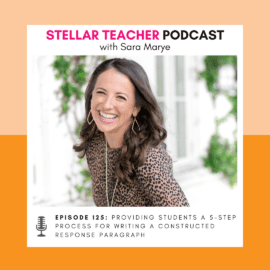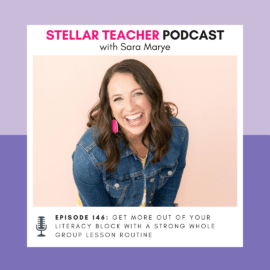
Click play below to hear how to master a constructed response:
We’re getting closer to the part of the school year that all teachers dread: standardized test season. Since giving the test is inevitable, test prep becomes part of our lessons and activities that prepare our students for success.
Recently, state tests have added a written portion, which adds another stressful element for students. In the first episode of the three part series, I’m sharing how to master a constructed response, which boosts students’ confidence.
Writing a constructed response is already challenging for students, so to write one independently on a state test can be even more difficult. Therefore, I’m sharing 6 strategies that will help your students feel more confident and experience a greater level of success when writing a constructed response
Each strategy shared is easy to implement, effective for your students, and helps develop and improve their written skills. Writing a constructed response, especially on a state test, can be stressful for students, but by providing tools to make them more confident, will ultimately help them be more successful!
Stay tuned to next week’s episode where I share my 5 step framework for writing a constructed response paragraph.
In this episode on mastering a constructed response, I share:
- 6 ways to help students feel confident with writing constructed responses
- Collaboration is the best way for students to practice and prepare
- Why constructed responses are challenging for students
- Ways to focus on writing skills that will help on the state test
Resources:
- Sentence Writing Routine Free Sample
- Check out the Stellar Teacher Reading Membership
- If you’re enjoying this podcast, please leave a review on Apple Podcasts!
Related episodes and blog posts:
- Episode 101, A Literacy Routine for Building Students’ Sentence Structure Skills
- Episode 75, 7 Test Prep Strategies for Student Success
- Episode 16, Engaging Test Prep Tips
- My Best Test Prep Tips for Upper Elementary Reading Teachers
Connect with me:
- Join my newsletter
- Shop my TPT store here
- Instagram: @thestellarteachercompany
More About Stellar Teacher Podcast:
Welcome to the Stellar Teacher Podcast! We believe teaching literacy is a skill. It takes a lot of time, practice, and effort to be good at it. This podcast will show you how to level up your literacy instruction and make a massive impact with your students, all while having a little fun!
Your host, Sara Marye, is a literacy specialist passionate about helping elementary teachers around the world pass on their love of reading to their students. She has over a decade of experience working as a classroom teacher and school administrator. Sara has made it her mission to create high quality no-fluff resources and lesson ideas that are both meaningful and engaging for young readers.
Each week, Sara and her guests will share their knowledge, tips, and tricks so that you can feel confident in your ability to transform your students into life-long readers.
Tune in on your favorite podcast platform: Apple, Google, Amazon, Spotify, Stitcher, and more! If you’re loving this podcast, please rate, review, and follow!
Podcast (stellar-teacher-podcast): Play in new window | Download
Hey, friend, happy Monday. Today, we are beginning a three episode series, all about test prep. Now, I don’t love standardized testing. I know you don’t love standardized testing, and I’m sure your students don’t love standardized testing. But the reality of it is it is part of our educational system. And I know you want your students to be successful, and I want you to be successful.
So we are going to take the next three weeks and we are going to talk all about different strategies that you can share with your students to help them feel more confident on their standardized test as well as to help them experience a greater level of success.
And today, we’re going to be talking about six tips that are going to help your students feel confident when writing their constructed response. I know that constructed response is a part of some standardized tests. And I know a lot more states are adding in this aspect to testing. And I also know that it’s something that teachers don’t necessarily feel super confident in teaching, and students might not feel confident in completing.
So I wanted to share some tips that are going to help your students feel a lot more confident with constructed response. So I think part of the reason why constructed response questions are challenging is because they require students to write an organized, detailed answer using evidence from a text and students struggle to write organized, detailed writing in general.
And then when they have the pressure of testing, it can just make it a little more challenging. I think they’re also tricky because they’re often two parts. So they might ask students to identify something or state a claim, and then provide reasons or evidence to back it up.
They also might ask students to apply their knowledge to make a change to a model or a visual, and then explain how that change would impact their results. So constructed responses really require students to have a higher level of critical thinking. And then they need to communicate their thinking in writing.
But regardless of the type of constructed response, and regardless of the type of thinking that they require students to complete, they really usually aren’t something that students are super familiar with, as necessarily like a multiple choice question.
You know, if you think about it, your students have probably been answering multiple choice questions for multiple years, they’ve probably seen them as early as second grade, maybe even first grade. So multiple choice feels a little more comfortable to students, where as constructed response on a test might not be something that they’re as familiar with, or as confident with.
And it’s possible that you don’t feel as confident or as prepared to help your students master the constructed response. So today, I wanted to share six things that you can do during your test prep season, to help your students feel more confident with the constructed response portion of their standardized test.
Okay, the first thing that you might want to consider doing is at the beginning of your test prep season, take some time to compare and contrast a constructed response prompt versus a multiple choice question. And you can just create a T chart or you could create a Venn diagram and identify you know, the attributes that are unique to a constructed response, identify the attributes that are unique to multiple choice, and identify some attributes that both types of questions have.
So you know, for example, a constructed response is a written response you write in complete sentences, you have to organize a coherent paragraph. Multiple choice, the answers are given for you and you have to select the best answer, but both types of questions require you to use evidence from the text and both types of questions require you to use critical thinking. And both types of questions require you to double check your answers.
And doing just a quick compare and contrast can be a great way to introduce constructed response to your students. And I think it can be helpful because it lets students what to know on the test, it gives you a chance to really break down constructed response and multiple choice.
And I think it helps students realize that there’s probably more similarities than they realize. You know, it can help them break down a constructed response to where it’s not so scary.
Okay, the second thing that you can do is practice sentence transformations. And a sentence transformation is when students take a question, and then transform it into a statement, or they take a statement and transform it into a question.
So for example, what is the first stage in a chickens lifecycle? And you can transform that into a statement, the first stage and the chickens lifecycle is the egg. Or you could give students a statement first and have them transform it into a question. The theme of the story is to work together as a team. If we want to put that into question, we would ask what is the theme of the story?
And a sentence transformation is a really quick and easy activity. You could do this every day at multiple points in the day, anytime students are seeing a question, you can have them transform it into a statement. And doing this type of activity is going to help your students in a few ways.
When students have to do a sentence transformation, it helps them understand what the question is asking, and how to answer it. It also can really give them confidence in developing a topic sentence. Because if students can take a question, and restate it as a statement, they can use that statement as their first sentence in their constructed response.
And if students are able to come up with a topic sentence that is responding to the prompt, and they’re going to be much more likely to stay on topic and answer the prompt correctly. So this is something that you could do, you’re not necessarily practicing a constructed response every day, although you could. But this is something that you could just do every day, multiple times a day, do it as a quick part of your transition.
You can even have students come up with a question, and then have them transform it into a statement. And that’s just going to help them have a little bit more confidence and knowing how to respond to the question being asked in the constructed response.
Okay, my third tip is don’t treat your constructed response practice, like the actual test. And I actually think that this is a common sort of danger or hazard that comes up during test prep season. We think that the best way to prepare our students is to give them practice tests in a simulated testing environment.
You know, the more experience and familiarity they have with how the test is going to look and go, the more successful they’re going to be. But that’s not the best way. You know, we don’t want the bulk of our test prep season to be consumed with independent practice where students are sitting at their desks not being able to talk through their answers, they’re having a time to test, you know, they’re going to experience that on test day.
We want our test prep season to actually help students feel more confident on a test, which means students need opportunities during test prep for collaboration, they need opportunities to learn from their peers and talk through, you know, if we’re talking about constructed response, to hear how other students are putting together their constructed response, students need to see a constructed response being modeled to them.
Students need to have opportunities for revising and editing and identifying, you know, mistakes or identifying weak parts of your constructive response and practicing it again, you know, they need opportunities to get and give feedback, and they need to see other examples of written responses.
So you should be practicing a constructed response with your students, but don’t treat it like the actual test. And I think collaboration is one of the best things that you can do. Let students work in a partnership or a group to create a constructed response. You know, give them feedback, talk through their response.
And I think the more collaborative and the more group conversation you can have around this, the more confident students are going to feel. So save the you know, sit down, and you’re going to be timed, and, you know, we’re not going to talk until the test is done. Save that for actual test day, but use your test prep to actually prepare your students and teach them and engage in dialogue and practice in conversation as a group.
Okay, my fourth tip is to focus on constructed response vocabulary. And I think this is really important because students need to understand what the prompt is asking them to do. And a really easy way that you can do this is to teach students to identify and circle the verbs in a constructed response, you know, as well as any other key vocabulary words, you know that the prompt is telling them.
And I pulled a couple examples from the Texas Star from their constructed response, exemplar. And one of the prompts is, what is the central idea of the article? Support your answer with evidence from the article.
So first, you know, they’re asking what is the central idea, which is basically identify the central idea. So students need to identify the central idea, and then they need to support their answer with evidence from the article, so students need to understand what does that verb support mean?
Another example is steamboats and clippers were popular forms of transformation in the United States in the 1800s. Explain whether you think the steamboat or the clipper ship changed life and the United States more.
So with this one, students need to understand that they have to identify either the steamboat or the clipper as being most impactful, which means they need to go back to the text and be able to understand what is the steamboat? What is the clipper, you know, what are attributes of both of them? But then they need to be able to explain which one changed life in United States more.
So there’s a couple key vocabulary words in there that are really essential for students to be able to fully respond to the prompt. So anytime you’re working on a constructed response, take a little bit of time, identify the verbs, identify, you know, the words that are directing students in their writing, you know, help students really sort of break down and annotate the prompt, so that way they know how to successfully respond to it.
Okay, my fifth tip is to continue to support students sentence writing development. And this doesn’t necessarily even have to be connected to a constructed response, but be intentional about helping students develop their ability to write a complete and coherent sentence.
And you know, if you think about it, a constructed response is all about students being able to clearly communicate their ideas in writing. And that is going to require them to write several complete sentences, you know, that are strung together around sort of the same idea.
But if your students aren’t able to write a complete sentence, if they’re not able to write detailed sentences, if they’re not able to, you know, combine ideas in a sentence, they’re probably going to struggle with their constructed response.
So one of the best things you can do is be intentional about enhancing and bolstering your students sentence writing skills. And we have a sentence writing routine, that is great for that. I will link to that in the show notes. And if you are a part of our reading membership, you already have access to this.
And I’ve talked about this sentence writing routine on the podcast before, but basically, throughout the week, every day, your students just get a really quick sentence writing tasks. So they might be expanding a sentence to add more details, they might be fixing a fragment and turning it into a complete sentence, they might be writing one of the four different sentence types, or they might be combining two sentences into one.
But whatever the sort of task is, it’s just going to give your students a lot more confidence in their ability to write complete sentences, which will help them feel more confident in their ability to write a complete constructed response. So even though you do want to spend some time actually practicing a constructed response, you don’t want to forget about focusing specifically on developing students sentence writing skills.
Okay, my last and final tip, then is provide students with a process or framework for writing a constructed response paragraph. And, you know, if students are going to have to respond to a constructed response prompt, it would be really helpful for them to kind of have a very general framework of what that looks like.
And so you can give your students just a very simple paragraph framework for how they can organize their constructed response, it could be something as simple as they’re gonna write a topic sentence, they’re gonna write two to three pieces of evidence, they’re going to include a concluding sentence, if that is applicable or appropriate for the prompt.
And, you know, we want students to be successful coming up with their constructed response. And if we can give them a framework for how to organize their paragraph, and almost like a checklist for how to put together a constructed response, they’re gonna feel a lot more confident in getting started.
You know, I think so much of this is giving students tools to when they see a constructed response prompt, they’re like, I know how to organize that. I know how to respond to that. I know how to write complete sentences to satisfy that prompt. So giving students a really simple process or framework for writing a constructed response paragraph can definitely help them.
Alright, so those are my six tips to help your students feel more confident on the constructed response portion of your end of your state test. I’ll just quickly review them.
One, spend some time to compare and contrast constructed response to multiple choice so that way your students understand what is expected at each part of the test. Second thing you should do is regularly practice sentence transformations. So students can take that question and rewrite it into a statement.
The third thing is don’t treat every constructive response like the actual test. Make sure you have room for collaboration, feedback, revising and true learning during your test prep season.
Tip number four is focus on vocabulary that students might see in a constructed response prompt, or help them learn how to annotate a prompt. Tip number five is support students with sentence writing, development and practice. And tip number six is to provide students with a framework for how to write their constructed response.
And if you’re looking for a little more support with that last step, be sure to tune in next Monday, I’m going to be sharing with you a simple five step framework. Really, it’s a checklist that you can share with your students that will help them write their constructed response, it’s going to be a great process or framework that you can use as you get ready for your constructed response portion of the test.
And there is a freebie included, you’re not going to want to miss it. So I hope you have a stellar week and I will see you back here next Monday.








Leave a Comment
You must be logged in to post a comment.